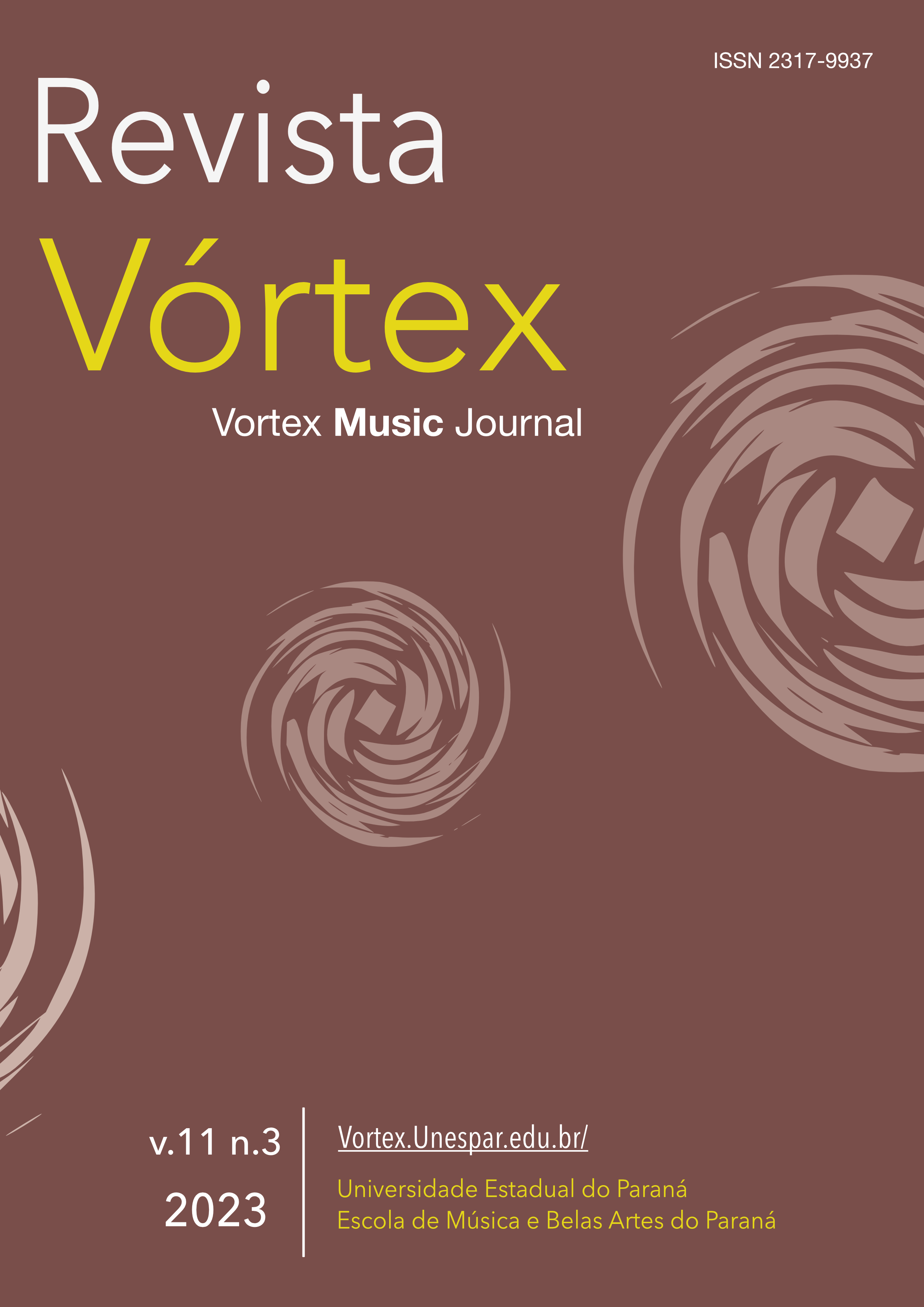Bimanual Coordination on the Guitar: an Experimental Study with Music Undergraduate Students
un estudio experimental con estudiantes de pregrado en Música
DOI:
https://doi.org/10.33871/23179937.2023.11.3.8145Keywords:
Classical Guitar, Bimanual Coordination on the Guitar (Coordenação Bimanual ao Violão - CBV), Guitar technique, Sonic VisualiserAbstract
Bimanual Coordination on the Guitar (Coordenação Bimanual ao Violão – CBV) is the joint action of both hands of a guitarist in the production of notes, responsible for the individual quality of each note and for the legato between them. Aiming at the quantitative analysis of this question, we investigated the CBV through its cues in collected audio recordings. For this, we made observational studies and an experiment with undergraduate and graduate guitar students of three institutions from different Brazilian regions. In the presente work, we discuss our second pilot study on the theme, carried out with four students from the Espírito Santo Music Faculty (FAMES - Bachelor of Music - Guitar). In our literature review, we addressed bimanual coordination in different instruments and the motor behavior of hands. After that, we present the elaboration, realization, results and discussion of our observational pilot.
Downloads
References
ARIAS, José Luis Gallo. Aspectos interpretativos no choro Nosso Choro de Garoto: uma análise de gravações. 2014. Dissertação (Mestrado, Música). Universidade Federal do Rio Grande do Sul, Porto Alegre, 2014.
BAADER, Andreas P.; KAZENNIKOV, Oleg; WIESENDANGER, Mario. Coordination of bowing and fingering in violin playing. Cognitive Brain Research, 23, 436-443, 2005.
COOK, Nicholas. Methods for analysing recordings. In: COOK, Nicholas; CLARKE, Eric; LEECH-WILKINSON, Daniel; RINK, John. The Cambridge Companion to Recorded Music. Cambridge: Cambridge University Press, 2009. 221-245.
GERLING, Fredi Vieira. O tempo rubato na Valsa de Esquina N.º 2 de Francisco Mignone. Claves, João Pessoa, v. 5, 7-19, maio de 2008.
GOEBL, Werner. Melody lead in piano performance: expressive device or artifact? Journal of the Acoustical Society of America, 110, 563-572, 2001.
GOEBL, Werner; FLOSSMANN, Sebastian; WIDMER, Gerhadr. Investigations into between-hand synchronization in Magaloff's Chopin. Computer Music Journal, 34(3), 35-44, 2010.
HÄGER-ROSS, Charlotte; SCHIEBER, Marc H. Quantifying the independence of human finger movements: comparisons of digits, hands, and movement frequencies. Journal of Neuroscience, 20 (22), 8542- 8550, novembro de 2000.
HOFMANN, Alex; GOEBL, Werner; WEILGUNI, Michael; MAYER, Alexander; SMETANA, Walter. Measuring tongue and finger coordination in saxophone performance. In: 12th International Conference on Music Perception and Cognition (ICMPC) and 8th Triennial Conference of the European Society for the Cognitive Sciences of Music (ESCOM), 2012, Aristotle University Thessaloniki, Thessaloniki, Grécia. Proceedings of the... Thessaloniki: ICMPC/ESCOM 2012, 2012. 442-445.
HOFMANN, Alex; GOEBL, Werner; WEILGUNI, Michael; SMETANA, Walter. Zooming into saxophone performance: tongue and finger coordination. In: International Symposium on Performance Science, 2013, Viena. Proceedings of the... Viena: AEC, 2013. 289-294.
HOLLANDER, Myles; WOLFE, Douglas A. Nonparametric statistical methods. New York: John Wiley & Sons, 1973.
KAZENNIKOV, Oleg; WIESENDANGER, Mario. Bimanual coordination of bowing and fingering in violinists: effects of position changes and string changes. Motor Control, 13(3), 297-309, 2009.
KILCHENMANN, Lorenz; SENN, Olivier. “Play in time, but don’t play time”: analyzing timing profiles in drum performances. In: International Symposium on Performance Science, 2011, Toronto. Proceedings of the... Toronto: AEC, 2011. 593-598.
LONDON, Justin; POLAK, Rainer. Microtiming in Ngòn: categorical production and perception of a non-isochronous meter. In: International Symposium on Performance Science, 2013, Viena. Proceedings of the... Viena: ARC, 2013. 645-650.
MACRITCHIE, Jennifer; EIHOLZER, Hubert. Playing hands together: exploring the use of asynchrony as an expressive device. In: International Symposium on Performance Science, 2013, Viena. Proceedings of the... Viena: AEC, 2013. 715- 720.
MATSCHULAT, Josias. Gestos musicais no Ponteio nº 49 de Camargo Guarnieri: uma análise e comparação de gravações. 2011. Dissertação (Mestrado, Música). Universidade Federal do Rio Grande do Sul, Porto Alegre, 2011.
MECHSNER, Franz; KERZEL, Dirk; KNOBLICH, Günther; PRINZ, Wolfgang. Perceptual basis of bimanual coordination. Nature, 414, 69-73, novembro de 2001.
OEHLERT, Gary W. A first course in design and analysis of experiments. Minnesota: W. H. Freeman, 2010. Disponível em: <http://users.stat.umn.edu/~gary/book/fcdae.pdf> . Acesso em: 31 de agosto de 2020.
SCHOONDERWALDT, Erwin; ALTENMÜLLER, Eckart. Mastering the violin: motor learning in complex bowing skills. In: International Symposium on Performance Science, 2011, Toronto. Proceedings of the... Toronto: AEC, 2011. 649-654.
SEMJEN, Andras; IVRY, Richard B. The coupled oscillator model of between-hand coordination in alternate-hand tapping: a reappraisal. Journal of Experimental Psychology Human Perception and Performance, vol. 27, n. 2, 251-265, 2001.
SENN, Olivier; KILCHENMANN, Lorenz; CAMP, Marc-Antoine. Expressive timing: Martha Argerich plays Chopin’s Prelude op. 28/4 in E minor. In: International Symposium on Performance Science, 2009, Auckland. Proceedings of the... Auckland: AEC, 2009. 107-112.
WIESENDANGER, Mario; SERRIEN, Deborah J. The quest to understand bimanual coordination. Progress in Brain Research, 143, 491-505, 2004.
Downloads
Published
How to Cite
Issue
Section
License
Copyright (c) 2023 Renan Colombo Simões, Daniel Wolff

This work is licensed under a Creative Commons Attribution 4.0 International License.
Autores mantêm os direitos autorais e concedem à revista o direito de primeira publicação, com o trabalho simultaneamente licenciado sob a Licença Creative Commons Attribution que permite o compartilhamento do trabalho com reconhecimento da autoria e publicação inicial nesta revista.






